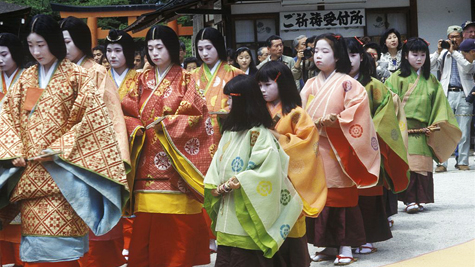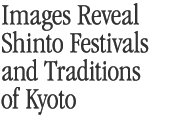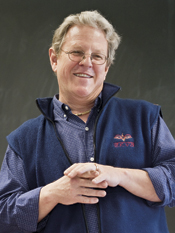

Saiin attendants in procession at Shimogamo Shrine. In an event preparatory to the main festival, the chosen representative of the Saio (saiodairi), accompanied by numerous attendants in court attire, is purified, the location alternating between Shimogamo and Kamigamo Shrines each year.
/ Published November 26, 2010
Ancient festivals and shrines are central to the practice of Shinto, the indigenous religion of Japan; yet many of these have gradually been altered over time. So when a trove of unusual color slides documenting Shinto festivals in Kyoto, Japan, recently surfaced, Smith College faculty and staff quickly took steps to make sure these cultural records wouldn’t be lost to the ages.
Now the voluminous collection of recently digitized images of these rituals offers scholarship and commentary for understanding how Japan’s cultural heritage has been shaped.
The Imaging Center, in the Brown Fine Arts Center, has been a leader in constructing a bridge between the explosion of analog media in the 20th century and the rapidly changing and growing demands of digital technology.

During the Aoi Matsuri (Aoi Festival), believed to be Kyoto’s oldest Shinto festival, an Imperial Messenger visits both of the Kamo Shrines (Kamigamo and Shimogamo). The festival is said to have started during the reign of the Emperor Kinmei (540-571) when rites to appease the kami (deities) were performed at the Shrines after severe storms had destroyed the harvests.
Color slides are a prime example of both an art form and a strategy for preservation that is falling by the wayside. The Imaging Center itself has over the years painstakingly catalogued 280,000 of them. Many more are tucked away in the private collections of Smith’s academic departments and their faculty members. As slide projectors become obsolete, faculty members have been urged to begin the process of digitizing their slide collections.
Professor of Religion Jamie Hubbard, the Yehan Numata Lecturer in Buddhist Studies, recognized early on the importance of the slide collection of his mentor-turned-friend and colleague David Boggett in Kyoto, Japan. Hubbard knew of Boggett’s proclivities for photographing and documenting the former capital city’s cultural heritage. On further investigation, Hubbard discovered that not only is Boggett’s slide collection, which concentrates on ancient Buddhist shrines and festivals, voluminous (60,000 in all) but that the scholarship and commentary Boggett brings to their presentation make for a unique learning experience. (See sidebar.)
The natural thing for Hubbard to do was to reach out to Elisa Lanzi, the Imaging Center director who came to the Department of Art in 1999 to coordinate the transition to digital. Lanzi had already devoted a good deal of her career to grappling with the myriad promises and challenges digitization holds for preservationists. Today she leads a collaborative team of art department and Educational Technology Services staff in building the LUNA Image Repository, a campuswide database for images.
Lanzi was excited to hear about Boggett’s slide collection and set about harnessing resources to bring them into the digital age. Those resources include an energetic coterie of Smith students who play a vital role in handling, evaluating and processing images as part of the center’s workflow. “We depend heavily on our students,” says Lanzi, “many of them who are with us for a few years end up moving into areas like library science or museum studies.”
The college recognized that the collection would be a unique contribution toward Smith’s commitment to global studies. Lanzi secured the support of ARTstor, an initiative of the Andrew W. Mellon Foundation. Based in New York City, it facilitates cooperation among educational institutions by providing access to shared resources in the digital environment.
The head of collection development for the Imaging Center, Sherry Poirrier, was called on to curate the integration of the Boggett collection into the college’s digitization activities and to oversee the specialized cataloging. Poirrier is an Ada Comstock scholar who graduated from the Smith art history program. Her background in Asian art and religion and extensive cataloging expertise made her the perfect fit for this project. She in turn hired third-year art history major Kirsten Eichholz to first cull a shipment of about 1,200 slides, and to then start marrying each of them to commentary provided by Boggett.
These are not the only words that are important in building a usable image archive. Those laboring in the field of cultural preservation understand the essential role of carefully chosen words that make up the “metadata”—meaning “data about data.” Increasingly important in the digital age, the words embedded in the metadata make images and image collections available through search engines. The identifying information must be meticulously correct, and it must adhere to standards and practices that allow scholars and teachers to summon highly relevant material with a few keystrokes.
Eichholz, who intends to find a job that speaks to her interest in art when she graduates in 2012, first delved into the world of cultural preservation through a work-study job in the Imaging Center. There she saw a posting for employment that involved digitizing slides and photos of Indian temples amassed by Marylin Rhie, a professor of East Asian studies and the Jessie Wells Post Professor of Art.
“In the imaging center you get to see just how much work goes into maintaining collections, keeping things organized and bringing in new stuff all the time,” says Eichholz.

Formerly the imperial capital of Japan, Kyoto City is known for its traditional festivals and is home to more than 2,000 temples and shrines. The city today is also the center of Japan's television and film industry.
Senior Julie Bomba, another work-study student in the Imaging Center, works on a project with Kiki Smith, professor of theatre, who oversees the college’s historic clothing collection. Bomba is cataloging images of artifacts in the collection taken by the center’s professional photographer, Dick Fish. She also is researching teaching images for Professor Smith, including some from The Costume Institute at the Metropolitan Museum of Art.
“This is part of our big initiative to put as much online as possible,” says Bomba. “It’s a new frontier in museum and curatorial efforts, and it’s really great to be involved in it.”
The Boggett project’s connection to ARTstor means that it will become part of a database that is available to scholars worldwide. Megan Marler, senior analyst for strategic initiatives, explains that ARTstor currently has 1.2 million images available to its 1,200 subscribers. It is only accessible by libraries and educational institutions, which protects its status as a repository for images that are used exclusively for pedagogy and not for commercial endeavors. ARTstor is especially keen to add slightly esoteric images to its holdings. Boggett’s slides, for instance, show a side of Shinto festivals that goes beyond what has today become a mainstay of Kyoto’s tourist industry.
The metadata accompanying the images make this collection especially noteworthy. Because the data is coming from Smith, ARTstor can be sure that it conforms to the highest standards. Lanzi, the Imaging Center’s director, “is a real leader within the community” of cultural preservationists, explains Marler. Besides working with the Getty Trust, Lanzi is chair of the project Cataloging Cultural Objects: A Guide to Describing Works and Their Images, which includes an American Library Association print publication and a Web site.
Marler further explains that Lanzi has “pushed the boundaries” in striving for consistency when capturing information that is entered as metadata. “She has an eye towards making that information sharable across institutions, so that it is promoting more collaborative types of endeavors rather than just describing an object for one particular need at that particular time. She’s got a much broader view.”



















